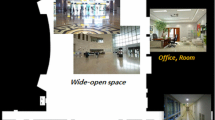Abstract
Multi-robot system has become a research hotspot because of low demand on the sensors’ accuracy, high reliability, and high efficiency. To put all the robots together, formation control is a crucial problem. In this paper, we propose a local position-based method to plan trajectories and build a pyramid pattern for a fleet of NAOs in the obstacle-free environment by refering to the position-based method and giving an O(n log n) collision avoidance strategy inspired from one graph theory, where the local positions are estimated from optical sensors. To get the local positions, an integrated image processing method is developped. Firstly a mask-base is generated to store the features of NAOs, and a cross-correlation method is introduced to recognize the NAO. Subsequently, the distance and angle models are proposed to get the local information from a single image. Then, a visual compass is introduced to obtain the orientation of one NAO. After the local information exchange by the WiFi communication, a neighbor-check method is put foward to distinguish the homogeneous NAOs (all the NAOs look like the same). Further, a common frame is constructed as an artificial global frame, and straight non-intercrossing trajectories are planned according to the O(n log n) collision avoidance strategy. At last, the performance of our proposed local position-based method is verified by the simulations with up to 15 robots and the indoor experiments with 3 NAOs in a real environment. The convergence of the method has been demonstrated in both obstacle-free and static obstacle environments.
Similar content being viewed by others
References
Gu D B. A game theory approach to target tracking in sensor networks. IEEE Trans Syst Man Cybern B, 2011, 41: 2–13
Jin Y C, Guo H L, Meng Y. A hierarchical gene regulatory network for adaptive multirobot pattern formation. IEEE Trans Syst Man Cybern B, 2012, 42: 805–816
Ahmad M D, Kasim M A A, Mohammed M A, et al. Multi-robot system for real-time sensing and monitoring. In: Proceedings of the 15th International Workshop on Research and Education in Mechatronics (REM), El Gouna, 2014
Arai T, Pagello E, Parker L E. Guest editorial advances in multirobot systems. IEEE Trans Robot Autom, 2002, 18: 655–661
Li X, Zhu D Q, Qian Y. A survey on formation control algorithms for multi-AUV system. Unmanned Syst, 2014, 2: 351–359
Benzerrouk A, Adouane L, Martinet P. Stable navigation in formation for a multi-robot system based on a constrained virtual structure. Robot Auton Syst, 2014, 62: 1806–1815
Balch T, Arkin R C. Behavior-based formation control for multirobot teams. IEEE Trans Robot Autom, 1998, 14: 926–939
Sun J Y, Tang J, Lao S Y. Collision avoidance for cooperative UAVs with optimized artificial potential field algorithm. IEEE Access, 2017, 5: 18382–18390
Loria A, Dasdemir J, Jarquin N A. Leader-follower formation and tracking control of mobile robots along straight paths. IEEE Trans Control Syst Technol, 2016, 24: 727–732
Oh K K, Park M C, Ahn H S. A survey of multi-agent formation control. Automatica, 2015, 53: 424–440
Alonso-Mora J, Breitenmoser A, Rufli M, et al. Optimal reciprocal collision avoidance for multiple non-holonomic robots. In: Proceedings of the 10th International Symposium on Distributed Autonomous Robotic Systems, Lausanne, 2010. 203–216
Paulos J, Eckenstein N, Tosun T, et al. Automated self-assembly of large maritime structures by a team of robotic boats. IEEE Trans Autom Sci Eng, 2015, 12: 958–968
Xia Y Q, Na X T, Sun Z Q, et al. Formation control and collision avoidance for multi-agent systems based on position estimation. ISA Trans, 2016, 61: 287–296
Nikou A, Verginis C K, Dimarogonas D V. Robust distance-based formation control of multiple rigid bodies with orientation alignment. 2017. ArXiv:1611.01824
Oh K K, Ahn H S. Distance-based control of cycle-free persistent formations. In: Proceedings of IEEE International Symposium on Intelligent Control, Denver, 2011. 816–821
Bartlett S L, Hampapur A, Huber M J, et al. Vision for mobile robots. In: Image Technology. Berlin: Springer, 1996
Fredslund J, Mataric M J. A general algorithm for robot formations using local sensing and minimal communication. IEEE Trans Robot Autom, 2002, 18: 837–846
Gouaillier D, Hugel V, Blazevic P, et al. Mechatronic design of NAO humanoid. In: Proceedings of IEEE International Conference on Robotics and Automation, Kobe, 2009. 769–774
Wang X M, Zerr B, Thomas H, et al. Pattern formation for a fleet of auvs based on optical sensor. In: Proceedings of OCEANS-17, Aberdeen, 2017
Kim Y, Mesbahi M. On maximizing the second smallest eigenvalue of a state-dependent graph Laplacian. IEEE Trans Autom Control, 2006, 51: 116–120
Alonso-Mora J, Breitenmoser A, Rufli M, et al. Multi-robot system for artistic pattern formation. In: Proceedings of IEEE International Conference on Robotics and Automation, Shanghai, 2011. 4512–4517
Yu S, Barca J C. Autonomous formation selection for ground moving multi-robot systems. In: Proceedings of IEEE International Conference on Advanced Intelligent Mechatronics, Busan, 2015. 54–59
Benozzi L. A detection strategy for line formation of a team of humanoid robots. Dissertation for Master Degree. Florence: University of Florence, 2017
Aldebaran: Nao software 1.14.5 documentation/hardware/nao technical overview/joints. 2013. https://doi.org/doc.aldebaran.com/1-14/family/robots/jointsrobot.html
Aldebaran: Nao software 1.14.5 documentation/reference/naoqi api/naoqi vision/alvisualcompass. 2013. https://doi.org/doc.aldebaran.com/1-14/naoqi/vision/alvisualcompass.html?highlight=compass
Fujinaga N, Yamauchi Y, Ono H, et al. Pattern formation by oblivious asynchronous mobile robots. SIAM J Comput, 2015, 44: 740–785
Aldebaran: Nao software 1.14.5 documentation/hardware/nao technical overview/contact and tactile sensors. 2013. https://doi.org/doc.aldebaran.com/1-14/family/robots/contact-sensorsrobot.html
Aldebaran: Nao software 1.14.5 documentation/hardware/nao technical overview/sonars. 2013. https://doi.org/doc.aldebaran.com/1-14/family/robots/sonarrobot.html
Acknowledgements
This work was supported by National Natural Science Foundation of China (Grant Nos. 61571478, 61601428, 51709245, 51509229).
Author information
Authors and Affiliations
Corresponding author
Rights and permissions
About this article
Cite this article
Wang, X., Benozzi, L., Zerr, B. et al. Formation building and collision avoidance for a fleet of NAOs based on optical sensor with local positions and minimum communication. Sci. China Inf. Sci. 62, 52205 (2019). https://doi.org/10.1007/s11432-018-9681-3
Received:
Revised:
Accepted:
Published:
DOI: https://doi.org/10.1007/s11432-018-9681-3




